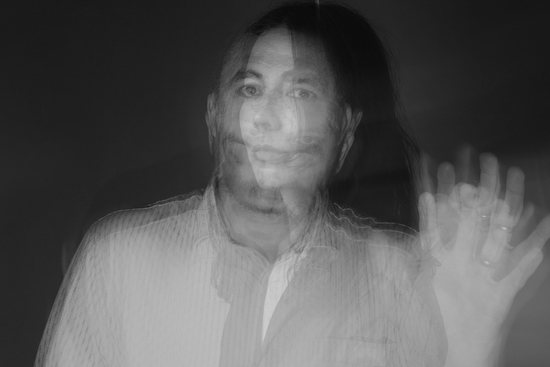©Lena Shkoda & Camille Blake
The cartoonish monsters of 1950s sci-fi teen flicks with a horror bent, like The Blob’s amorphous red man-eating blob, strike an uncanny balance between silliness and fright. In The Blob’s case, a sinister, gelatinous substance spawned from a meteor haunts a suburban town, ever-expanding as it engorges itself, while the townspeople engage in goofy dialogue and make exaggerated facial expressions. The entire concept is ridiculous – but the equally weighted quirkiness and horror makes it all the more endearing.
That delightful mix of humour and outer-space terror permeates through Lucrecia Dalt and Aaron Dilloway’s debut duo album, Lucy & Aaron. Their funky sounds are at-once arresting and lighthearted, zooming through mysterious noises and irresistible beats. It often feels as if they’re speaking in some far-away, extraterrestrial language, as their garbled words seep into gritty, robotic sounds. On one of the more spine-chilling tracks on the album, ‘Both Blue Moons’, a powerful strum echoes in cavernous emptiness, a space so immense the air can be heard swishing amongst its hollow walls. The gritty tone reverberates as if it’s floating in this sprawling cavity, slow-moving and suspended in time as a high pitch swirls around it. Creaks, croaks, and random vocalisations ooze out while an ominous chant hums beneath the quiet chaos. It’s certainly spooky, but it’s also compellingly peculiar.
While Lucy & Aaron is technically the duo’s first album, the two musicians share a history of live performance together, and an admiration of each other’s work. On a surface level, each artist’s individual practice seems opposite from the other: Dalt’s music drifts while Dilloway’s pummels, Dalt’s music lilts while Dilloway’s grimaces. But on Lucy & Aaron, they find a way to mesh gauziness with darkness to lucid results. In their artist statements, each artist expresses the aspects of each other’s music they most enjoy: Dilloway’s eerie grooves, Dalt’s ease with a mixing board. They’re admitted fans of each other’s work, and Dalt even calls their friendship “extremely close and utopian.” That closeness comes through in the ease with which Lucy & Aaron slips through its multiple faces, seamlessly gliding through the most pummelling glitches to get to the most exquisite tones.
Since their initial, brief meeting ten years ago, Dalt and Dilloway have performed across the United States and Canada, combining their penchant for different musical textures into explosive live events. Last year, they explored field recordings together, releasing an album that features solo works by each artist called Field Recordings In The Forest Of Colombia; the year before that, they released Dragon Loops, a cassette of mangled noises. These endeavours have often highlighted the artists as individuals, placing their artistic voices side-by-side in a whirlwind. Instead, Lucy & Aaron sees the two unite their differences into one package that admires its consonances as much as its dissonances.
And while the marriage of two musical styles is the grounding force of Lucy & Aaron, the album is surprisingly cohesive. ‘Yodeling Slits’ exemplifies sci-fi scariness mixed with whimsy, as a sharp whip slices through a distant hum and harrowing repetitions grind beneath. Dalt’s voice slithers through a series of haunted tones, manipulated so that it sounds like it’s reverberating into a bottomless void. Shreds of melodies ripple between the shadowy exterior, hinting at a playfulness that penetrates the music’s thick, uneasy atmosphere. That mysterious energy returns in the next track, ‘Bordeándola’, which features a voice transformed to sound like a garbled robot, speak-singing in stilted motion above bouncy electronic droplets that keep a beat. This mystery persistently comes to life as the album swings, like a pendulum, from forbidding repetitions to perky rhythms and right back again.
Dalt and Dilloway crafted Lucy & Aaron in three locations – Pioneer Works in Brooklyn, Dalt’s home in Berlin, and Dilloway’s home in Oberlin, Ohio – but it’s impossible to tell the album came together in piecemeal. Each track slips effortlessly into the next, meticulously morphing from one rhythm to another. One of the album’s most melodic tracks, ‘The Blob’, a strong, stoic voice hums above churning beats and punchy, electric rings. It easily slips into ‘Tense Cuts,’ which ditches the voice in favour of bursting beats and abstract chatter, keeping the upbeat feeling of ‘The Blob’, but moving back into the more otherworldly, abstract realms that Dalt and Dilloway know so well.
Lucy & Aaron is, at its heart, a series of careful decisions about when to unleash humour and when to wreak havoc. With ‘Niles Baroque’, all the threads the two musicians lay down are tied together into one neat bow, especially showcasing the music’s delicate balancing act. Dalt’s voice, more natural and less manipulated than on other tracks, floats above an undulating electronic groove that asserts itself in powerful repetition, gently growing into a chorus, steady and upbeat. None of the melodies on the track feel all that complex, but they’re stacked in hypnotic layers, until a creepy voice finally enters, almost unintelligible, and the song slowly breaks into pieces. It’s a groove that’s reached its final destination, fully launching us into an alternate dimension. And that resting place isn’t quite utopian or dystopian – it’s a little bit of both.


